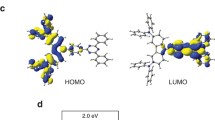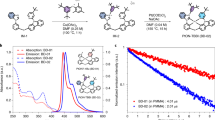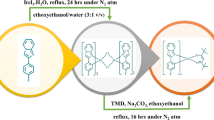Abstract
The efficiency of electroluminescent organic light-emitting devices1,2 can be improved by the introduction3 of a fluorescent dye. Energy transfer from the host to the dye occurs via excitons, but only the singlet spin states induce fluorescent emission; these represent a small fraction (about 25%) of the total excited-state population (the remainder are triplet states). Phosphorescent dyes, however, offer a means of achieving improved light-emission efficiencies, as emission may result from both singlet and triplet states. Here we report high-efficiency (≳90%) energy transfer from both singlet and triplet states, in a host material doped with the phosphorescent dye 2,3,7,8,12,13,17,18-octaethyl-21H,23H-porphine platinum(II) (PtOEP). Our doped electroluminescent devices generate saturated red emission with peak external and internal quantum efficiencies of 4% and 23%, respectively. The luminescent efficiencies attainable with phosphorescent dyes may lead to new applications for organic materials. Moreover, our work establishes the utility of PtOEP as a probe of triplet behaviour and energy transfer in organic solid-state systems.



Similar content being viewed by others
References
VanSlyke, S. A. & Tang, C. W. US Patent No. 4539507 ((1985)).
Burroughes, J. H.et al. Light emitting diodes based on conjugated polymers. Nature 347, 539–541 (1990).
Tang, C. W., VanSlyke, S. A. & Chen, C. H. Electroluminescence of doped organic thin films. J. Appl. Phys. 65, 3610–3616 (1989).
Tsutsui, T. & Saito, S. Organic Multilayer-Dye Electroluminescent Diodes—Is There Any Difference with Polymer LED? (Kluwer Academic, Dordrecht, (1993)).
Rothberg, L. J. & Lovinger, A. J. Status of and prospects for organic electroluminescence. J. Mater. Res. 11, 3174–3187 (1996).
Gu, G.et al. High-external-quantum-efficiency organic light-emitting devices. Opt. Lett. 22, 396–398 (1997).
Dirr, S.et al. Vacuum-deposited thin films of lanthanide complexes: spectral properties and applications in organic light-emitting devices.In SID 97 Digest(ed. Morreale, J.) 778–781 (Soc. for Information Display, Santa Ana, CA, (1997).
Hoshino, S. & Suzuki, H. Electroluminescence from triplet excited states of benzophenone. Appl. Phys. Lett. 69, 224–226 (1996).
Mills, A. & Lepre, A. Controlling the response characteristics of luminescent porphyrin plastic film sensors for oxygen. Anal. Chem. 69, 4653–4659 (1997).
Ponterini, G., Serpone, N., Bergkamp, M. A. & Netzel, T. L. Comparison of radiationless decay processes in osmium and platinum porphyrins. J. Am. Chem. Soc. 105, 4639–4645 (1983).
Papkovski, D. B. New oxygen sensors and their applications to biosensing. Sens. Actuators B 29, 213–218 (1995).
Turro, N. J. Modern Molecular Photochemistry (University Science Books, Mill Valley, CA, (1991)).
Liu, H.-Y., Switalski, S. C., Coltrain, B. K. & Merkel, P. B. Oxygen permeability of sol-gel coatings. Appl. Spectrosc. 46, 1266–1272 (1992).
Rodriguez, J., McDowell, L. & Holten, D. Elucidation of the role of metal to ring charge-transfer states in the deactivation of photo-excited ruthenium porphyrin carbonyl complexes. Chem. Phys. Lett. 147, 235–240 (1988).
Bulovic, V.et al. Bright, saturated, red-to-yellow organic light-emitting devices based on polarization-induced spectral shifts. Chem. Phys. Lett. 287, 455–460 (1998).
Chen, C. H., Tang, C. W., Shi, J. & Klubeck, K. P. Improved red dopants for organic electroluminescent devices. Macromol. Symp. 125, 49–58 (1997).
Tsutsui, T., Takada, N., Saito, S. & Ogino, E. Sharply directed emission in organic electroluminescent diodes with an optical-microcavity structure. Appl. Phys. Lett. 65, 1868–1870 (1994).
Kido, J.et al. Bright red light emitting organic electroluminescent devices having a europium complex as an emitter. Appl. Phys. Lett. 65, 2124–2126 (1994).
Sano, T.et al. Novel europium complexes for electroluminescent devices with sharp red emission. Jpn J. Appl. Phys. 34, 1883–1887 (1994).
Garbuzov, D. Z., Bulovic, V., Burrows, P. E. & Forrest, S. R. Photoluminescence efficiency and absorption of aluminum-tris-quinolate (Alq3) thin films. Chem. Phys. Lett. 249, 433–437 (1996).
Acknowledgements
We thank V. G. Kozlov for help with the transient measurements, and P. E. Burrows for discussions. This work was supported by Universal Display Corporation, DARPA, AFPSR and NSF.
Author information
Authors and Affiliations
Rights and permissions
About this article
Cite this article
Baldo, M., O'Brien, D., You, Y. et al. Highly efficient phosphorescent emission from organic electroluminescent devices. Nature 395, 151–154 (1998). https://doi.org/10.1038/25954
Received:
Accepted:
Issue Date:
DOI: https://doi.org/10.1038/25954
- Springer Nature Limited
This article is cited by
-
Enhancing the efficiency and stability of blue thermally activated delayed fluorescence emitters by perdeuteration
Nature Photonics (2024)
-
Chiral materials and mechanisms for circularly polarized light-emitting diodes
Nature Photonics (2024)
-
Stable blue phosphorescent organic LEDs that use polariton-enhanced Purcell effects
Nature (2024)
-
Charge trapping for controllable persistent luminescence in organics
Nature Photonics (2024)
-
Tuning of the Singlet–Triplet Energy Gap of Donor-Linker-Acceptor Based Thermally Activated Delayed Fluorescent Emitters
Journal of Fluorescence (2024)





